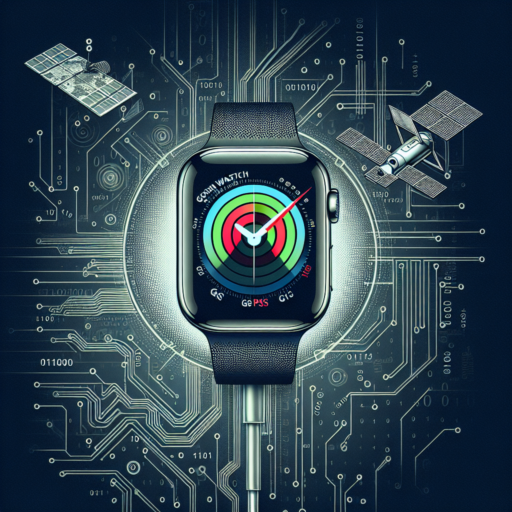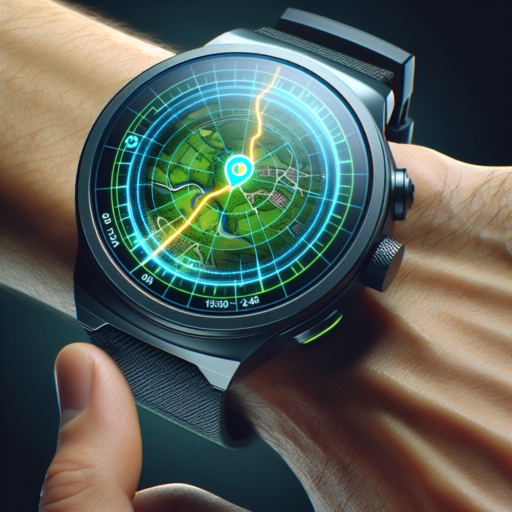Understanding the Basics of Apple Watch GPS Technology
The Apple Watch GPS technology has revolutionized the way users interact with their environment, offering precise and real-time location tracking capabilities. This feature is fundamental for a wide array of functionalities, from fitness tracking to navigation assistance. Understanding the basics of how GPS technology works in the Apple Watch can enhance user experience and leverage the device’s full potential.
At its core, the GPS system used by the Apple Watch relies on a network of satellites orbiting the Earth. These satellites continuously transmit signals that are received by GPS receivers, like the one in your Apple Watch, to calculate your exact location. The process involves measuring the time it takes for the signals to travel from the satellites to the receiver. By using the data from multiple satellites, the watch can pinpoint your location with remarkable accuracy.
Accuracy and Factors Affecting Performance are crucial aspects to consider when discussing Apple Watch GPS technology. The system is designed to offer near-perfect location tracking under ideal conditions. However, factors such as obstructions (buildings, trees, etc.), atmospheric conditions, and even the way you wear your watch can affect this accuracy. Users looking to maximize the benefits of their Apple Watch’s GPS feature should be mindful of these potential barriers.
Lastly, utilizing GPS technology impacts the battery life of the Apple Watch. While Apple has made significant advancements in energy efficiency, continuous use of GPS can still drain the watch’s battery quicker. It’s important for users to balance the need for precise location tracking with the overall battery life of their device, especially during extended use like outdoor workouts or adventures.
How Apple Watch Uses GPS to Enhance Your Fitness Experience
The integration of GPS technology in the Apple Watch has revolutionized the way athletes and fitness enthusiasts track their workouts and activities. This advanced feature enables users to monitor their exact location throughout any outdoor activities, such as running, cycling, or even swimming. By analyzing the data collected via GPS, the Apple Watch offers insights that can significantly improve your fitness routine and help achieve your exercise goals more effectively.
One of the key benefits of GPS functionality in the Apple Watch is its ability to accurately measure the distance covered during an outdoor workout. This precision allows for an enhanced understanding of performance and progress over time. Whether you are a marathon runner aiming to improve your time, or a casual walker trying to increase your daily steps, the Apple Watch uses GPS data to provide invaluable feedback on your physical activities.
Moreover, the Apple Watch leverages GPS data to offer tailored recommendations and coaching. Based on your tracked activity, the device can suggest personalized workout plans that align with your fitness levels and goals. This bespoke approach ensures that you are not only staying active but also working towards improving your performance in a way that is optimized for your personal health objectives.
Comparing GPS Capabilities: Apple Watch Series Comparisons
When discussing wearable technology, the GPS capabilities of the Apple Watch series often come to the forefront of the conversation. Each iteration of Apple’s iconic smartwatch has brought improvements and refinements to its GPS functionality, making it a key feature for fitness enthusiasts, avid travelers, and anyone in need of accurate location tracking. This focus aims to provide a detailed comparison of the GPS capacities across different Apple Watch models to help users identify which series best suits their needs.
Enhancements through the Generations
The evolution of GPS capabilities in the Apple Watch series has been both significant and user-focused. Starting from the Series 2, where Apple first introduced built-in GPS, enabling users to leave their iPhones behind during workouts, to the latest models, which offer more advanced features like precision tracking and faster signal locks. This progression illustrates not only technical advancements but also Apple’s commitment to enhancing user experience in outdoor activities and fitness tracking.
Model-Specific GPS Features
Diving deeper into model-specific capabilities can shed light on which Apple Watch might be the perfect companion for your activities. For instance, the Series 3 marked a notable improvement in signal acquisition time, while the Series 5 and later introduced an always-on altimeter, invaluable for hiking and elevation tracking. Each model brings a layer of specificity to GPS tracking, from basic location tracking to detailed route mapping and environmental adaptation, highlighting the technological strides Apple has made in this field.
Maximizing Battery Life While Using GPS on Your Apple Watch
Utilizar la función GPS de tu Apple Watch durante actividades al aire libre o entrenamientos es increíblemente útil para rastrear movimientos precisos. Sin embargo, puede consumir significativamente la batería del dispositivo. Afortunadamente, hay varios métodos probados para optimizar el uso de la batería mientras se disfruta de las ventajas del GPS.
Reducir el Brillo de la Pantalla
Una manera sencilla pero efectiva de ahorrar batería es ajustar el brillo de la pantalla de tu Apple Watch. Una pantalla muy brillante puede agotar rápidamente la batería, especialmente durante el uso prolongado del GPS. Considera configurar el brillo al nivel más bajo posible que aún sea cómodo para ti, lo cual puede hacerse rápidamente a través del Centro de Control o la aplicación de Ajustes en tu reloj.
Limitar las Notificaciones y Apps en Ejecución
Mientras utilizas el GPS, mantener al mínimo las notificaciones y aplicaciones en segundo plano puede contribuir significativamente a preservar la batería. Las notificaciones constantes no solo son una distracción, sino que también consumen recursos del sistema y batería. Desde la aplicación de Ajustes en tu iPhone, puedes seleccionar qué aplicaciones tienen permitido enviarte notificaciones, reduciendo así el consumo de energía.
Otra clave para maximizar la duración de la batería es cerrar las apps que no necesites mientras usas el GPS. Esto se puede hacer a través de la interfaz de cambio de apps en el Apple Watch, asegurándote de que solo las aplicaciones esenciales estén activas. Recordar estos pequeños ajustes puede prolongar significativamente la vida útil de la batería, permitiéndote disfrutar de la funcionalidad del GPS sin preocuparte por encontrar el próximo cargador.
Step-by-Step Guide: How to Enable GPS on Apple Watch
Enabling GPS on your Apple Watch can greatly enhance your experience, especially for activities such as running, cycling, and hiking. This guide will take you through a simple, step-by-step process to ensure that you can utilize the GPS functionality to its full extent. Whether you’re an avid fitness enthusiast or simply enjoy the convenience of map navigation on your wrist, follow these instructions to get started.
Accessing the Settings on Your Apple Watch
The first step to enabling GPS on your Apple Watch is to navigate to the settings. You can do this directly on your Apple Watch by pressing the Digital Crown until you see the home screen. Then, locate and tap the Settings icon, which looks like a gear. Scroll down until you find Privacy, and tap on it. Here, you will see the option for Location Services, which you need to ensure is turned on.
Adjusting Location Services
With Location Services enabled, your next step is to manage how apps use your location. In the Location Services menu, you’ll find a list of apps that have requested access to your location. It’s crucial to review these settings and adjust them according to your preferences. For apps that you use for fitness tracking or navigation, such as Apple Maps, make sure to select While Using the App. This ensures that the GPS is actively providing data when you’re using the app, but not draining your battery when you’re not.
Remember, the availability and performance of GPS and other location services can be affected by several factors, including your device settings, network connectivity, and whether your surroundings enable a clear view of the sky. Always ensure your Apple Watch is charged and has a good connection to your iPhone to get the most accurate and reliable GPS data.
The Accuracy of Apple Watch GPS: What You Need to Know
When it comes to tracking your movements, whether you’re a seasoned runner, an avid walker, or just someone who likes to keep track of their daily activities, the Apple Watch has become a go-to device for many. The built-in GPS functionality of the Apple Watch is one of its most praised features, offering users the ability to track their routes, pace, and distance without the need to carry their iPhone with them. But, how accurate is the GPS on the Apple Watch, and what factors can affect its performance?
Firstly, it’s essential to understand that the Apple Watch utilizes both GPS and GLONASS satellites to pinpoint your location. This dual-system approach is designed to enhance location accuracy and speed up the time it takes for the watch to acquire a GPS signal. In optimal conditions—clear skies, minimal obstructions, and open areas—the GPS accuracy of the Apple Watch is remarkably precise. Users typically find that the distance measurements are close to perfect when compared to other premium GPS devices. However, the accuracy can be affected by several factors including tall buildings, dense forests, and even atmospheric conditions.
Moreover, the latest models of the Apple Watch come equipped with additional sensors and enhancements that further improve GPS accuracy. For instance, the Apple Watch Series 5 and later models feature an always-on altimeter that provides real-time elevation tracking—a useful addition for hikers and climbers. Additionally, the integration of machine learning algorithms helps to correct any GPS drifts by learning your most frequented routes.
Navigating with Your Apple Watch: Tips and Tricks
Using your Apple Watch for navigation is like unlocking a digital compass that guides you through city streets, trails, and even your daily tasks. To make the most out of this feature, understanding some basic yet powerful tips and tricks can enhance your experience. Whether you are strolling through a new city or trying to find the best route for your morning jog, your Apple Watch becomes an indispensable tool right on your wrist.
Maximizing Battery Life for Extended Use
One of the key aspects to ensure smooth navigation with your Apple Watch is managing its battery life. Starting your journey with a full charge is recommended, but there are also settings you can adjust to extend battery life. Consider reducing the wake screen time or enabling Power Saving Mode during workouts to ensure you have enough juice to reach your destination. These simple adjustments can make a significant difference in your Apple Watch’s performance when you need it most.
Utilizing the Vibrant Taptic Engine for Directions
Another incredible feature of the Apple Watch is the use of the Taptic Engine to provide feedback as you navigate. Instead of constantly looking at your watch screen, the Taptic alerts can notify you about upcoming turns or when you need to change your route. This hands-free approach not only makes navigation effortless but also enhances your safety, especially while navigating busy streets. Paying close attention to these subtle taps can completely change the way you interact with your surroundings, thanks to your Apple Watch.
How Apple Watch GPS Integrates with Third-Party Apps
The Apple Watch has become an indispensable gadget for fitness enthusiasts and individuals who require precise location tracking for their daily activities. Its GPS capabilities are uniquely integrated with third-party apps, enhancing user experience and functionality. Through the Apple Watch’s accurate GPS, third-party developers are empowered to design apps that cater to a wide array of needs, from navigation to fitness tracking.
One significant way Apple Watch GPS integrates with third-party apps is through its comprehensive API (Application Programming Interface) provided by Apple. This API allows developers to access raw GPS data, which can be used to create detailed and customized experiences for the user. For instance, fitness apps utilize this GPS data to track runs, hikes, and cycling routes, providing users with in-depth analytics about their activities. This seamless integration between the watch’s GPS and apps ensures that users have access to accurate and real-time data to meet their fitness and navigation goals.
Moreover, the integration extends beyond just fitness and navigation. Third-party apps leveraging Apple Watch’s GPS include social media platforms for geo-tagging, photography apps for location-based photo tagging, and even gaming apps that require real-world location data to enhance the gaming experience. The adaptability of the Apple Watch GPS with these diverse applications showcases its robustness and the innovative possibilities it offers to both developers and users alike.
The collaboration between Apple Watch’s GPS technology and third-party apps not only enriches the app ecosystem but also sets a high standard for wearable technology integration. It provides a glimpse into the future, where wearable devices will play a crucial role in bridging the gap between digital applications and real-world experiences. As third-party developers continue to tap into this integration, Apple Watch users can anticipate even more creative and useful applications making their way into the market.
Understanding the Limitations of GPS Technology in Apple Watch
While the GPS technology integrated into the Apple Watch provides numerous benefits, from tracking your fitness activities to navigating unfamiliar locations, it is not without its limitations. Understanding these limitations is crucial for users who rely heavily on the Apple Watch’s GPS feature for their daily activities or for specific purposes like training and exploration.
Accuracy Concerns in Various Environments
One of the primary challenges users might face is the fluctuation in GPS accuracy. The Apple Watch, despite its advanced technology, can sometimes deliver less accurate location data in certain environments. Urban areas, with their tall buildings and narrow streets, can lead to a “canyon effect” that disrupts GPS signals. Similarly, dense forests or mountainous terrain can also significantly affect the accuracy of the GPS, making it less reliable in tracking precise movements or pinpointing exact locations.
Impact on Battery Life
Another considerable limitation of using GPS technology on the Apple Watch is its impact on battery life. GPS features are known to be energy-intensive. Continuous use of GPS tracking for activities like long-distance running, hiking, or biking can drain the watch’s battery much faster than typical daily use. Users planning to rely on GPS for extended periods need to plan accordingly, possibly adjusting settings for optimal battery life or considering alternative solutions during their activities.
Dependence on External Factors for Optimal Performance
Furthermore, the effectiveness of GPS technology in the Apple Watch is heavily dependent on external factors. Elements such as weather conditions, satellite positioning, and even interference from electronic devices can play a significant role in the performance of GPS. These factors might not only affect the accuracy but can occasionally cause delays in GPS signal reception or loss of connection, impacting the overall user experience.
No se han encontrado productos.
Solving Common GPS Issues on Apple Watch
Experiencing problems with GPS on your Apple Watch can be frustrating, especially when it affects your exercise tracking or navigation. The good news is that most GPS issues can be resolved with a few troubleshooting steps. This guide outlines practical solutions to help you fix common GPS problems on your Apple Watch, ensuring that your device accurately tracks your location and movements once again.
Check Your Location Services Settings
One of the first things you should verify is the Location Services settings on your iPhone, which impacts your Apple Watch as well. Navigate to Settings > Privacy > Location Services on your iPhone and ensure that Location Services is turned on. Also, check that Apple Watch Workout and Maps have permission to access your location. Adjusting these settings can restore full GPS functionality to your watch.
Ensure Your Apple Watch’s Software is Up to Date
Outdated software can cause various issues, including GPS malfunctions. To eliminate this as a potential problem, open the Watch app on your iPhone, head to General > Software Update, and install any available updates. Keeping your Apple Watch updated ensures you have the latest features and bug fixes, which may solve existing GPS issues.
Restart and Resync Your Apple Watch
If adjusting settings and updating software doesn’t fix the GPS problem, try restarting your Apple Watch. Press and hold the side button, slide to power off, and then turn it back on after a few seconds. In some cases, resyncing your Apple Watch with your iPhone is also beneficial. Open the Watch app on your iPhone, go to My Watch > General > Reset > Reset Sync Data. This action won’t erase any content but can refresh the connection and potentially fix GPS tracking issues.




